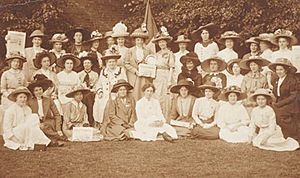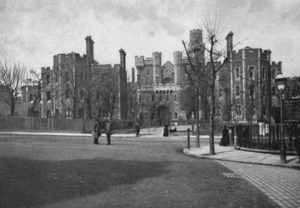Constance Bryer facts for kids
Constance Elizabeth Bryer (born July 1870 – died 12 July 1952) was a talented British violinist. She was also a strong supporter of women's rights and a dedicated activist. Constance was a suffragette, which means she fought for women to have the right to vote. When she was in Holloway Prison, she went on a hunger strike. This meant she refused to eat. Because of her hunger strike, she was force-fed.
Early Life and Family
Constance Bryer was born in Islington, London, in 1870. She was the oldest of seven children. Her father, Thomas John Bryer, was a wool merchant. Her mother was Elizabeth Butler. In 1908, Constance was a violinist living with her family in London. Her brother, Gilbert William Bryer, served in the Royal Garrison Artillery during World War I. He sadly died while serving and is buried in Highgate Cemetery.
Fighting for Women's Vote
Constance Bryer joined two important groups: the Women's Social and Political Union (WSPU) and the Church League for Women's Suffrage (CLWS). The WSPU was a leading group that used strong actions to get women the right to vote. The CLWS was a group of church members who also supported women's voting rights. Constance even stopped her music career to focus on campaigning for women's rights.
Her family also supported the cause. Her relative, George Bryer, played in a band during a big WSPU march in 1908. Her sister, Pearl, was a cellist who studied with a famous musician named Paderewski.
From 1911 to 1913, Constance was the Secretary for the WSPU's North Islington branch. She was involved in a protest called 'Black Friday' in 1910. She was arrested for blocking the way but was later released. In 1911, she also avoided the official census survey. She did this by not being at her family home when officials came to collect information. This was a form of protest against the government.
Later in 1911, Constance was arrested again. This was during a WSPU protest against the government stopping a bill that would have given some women the right to vote. She was sentenced to five days in prison for this.
Time in Prison
In May 1912, Constance Bryer was sentenced to four months in HM Prison Birmingham. She had broken windows on Regent Street in London as part of a protest. While in prison, she became good friends with another suffragette named Olive Wharry.
Constance and other suffragette prisoners went on a hunger strike while in Birmingham prison. During this time, Constance wrote a poem in an autograph album:
Suffragettes we sit and sew
Sew and sit and sit and sew
Twenty-five are we:
Making shirts and socks for men
Cannot get away from them
Even here you see.
This poem shows how the women kept their spirits up even in prison.
Later Life and Legacy
Constance Bryer remained friends with Olive Wharry throughout her life. When Olive Wharry passed away, she left Constance a regular payment of £200. She also left Constance her special Hunger Strike Medal and some of her artworks and books. Both Constance and Olive's hunger strike medals are now kept together in a private collection.
During World War II, Constance's home was damaged by bombs. She had to move to a new place in London, which she shared with her sister Angela. In her later years, she suffered from nerve pain called sciatica. In 1951, a musician named Adela Verne asked Constance to play in a concert. However, Constance felt she was too out of practice.
Constance Bryer passed away in July 1952 at the age of 82. She died at the Whittington Hospital in London. In her will, she left money to her unmarried sisters, Emmeline Beatrice Bryer and Evelyn Maude Bryer.




